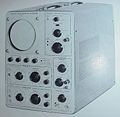502: Difference between revisions
No edit summary |
No edit summary |
||
| Line 25: | Line 25: | ||
==Prices== | ==Prices== | ||
{| class="wikitable" | {| class="wikitable" | ||
|- | |- | ||
Revision as of 07:18, 25 April 2018
The Tektronix 502 is a dual-beam oscilloscope introduced in 1958, followed by the 502A in 1963.
Both beams have differential inputs.
Specifications
When set for maximum sensitivity, the 502A is 100 μV/cm and has a vertical bandwidth of 50 kHz. At lower sensitivity settings the bandwidth increases - at 200 mV/cm the bandwidth is 1 MHz. At 100 mV/cm and 1 kHz, the common-mode rejection ratio of the 502A is 40,000:1.
- please add
Models
There is a 502, a 502A, and a rack-mount model, the RM502A.
Prices
| Year | 1959 | 1961 | 1963 (A) | 1971 (A) |
|---|---|---|---|---|
| Catalog price | $825 | $825 | $1,050 | $1,265 |
| 2018 value | $7,070 | $6,890 | $8,560 | $7,790 |
Internals
There is a transistor-regulated 6.2 VDC heater supply for the tubes in the first stage differential amplifier. This heater supply uses the -150 V supply as its reference. The -150 V supply uses a 5651 voltage reference tube as its reference. There is no post-deflection acceleration. The CRT cathode voltage is -2900 V.
Mod 104 on a 502 provides single sweep lockout.
Later 502A have solid state (include nuvistor) input stage, a 6DJ8 as the deflection amplifier and transistors as amplifiers and cathode followers (only in the newest version).
The 502 uses a single supply for the upper beam and lower beam CRT cathodes. The 502A has separate supplies for the two CRT cathodes. This improvement in the 502A allows slight differences in horizontal CRT sensitivity between the two beams to be canceled out in step 8 of the calibration procedure.
Links
- Tektronix 502A @ amplifier.cd (many internal pictures)
Pictures
502
-
-
-
502 front view
-
Image magnified from a flyer
-
502 left
-
502 right
-
502 bottom
502A
-
502A
-
502A right internal
-
502A right
-
502A left
-
502A rear
-
Solid-state input stage with two 6DJ*
-
502A vertical amp sn 25,997 to 30,999
RM502A
-
RM502A
-
RM502A rear
-
RM 502A
-
RM 502A display
-
RM 502A bottom
-
RM 502A transformer wiring
-
RM 502A top
-
RM 502A vibration-isolated vertical amp
Third version 502A, serial number greater than 31,000
-
top side lower beam input amp and attenuator, bottom side of upper beam vert input board
-
late model RM502A
-
late model RM502A
-
late model RM502A
-
late model RM502A
-
late model RM502A
-
late model RM502A
-
late model RM502A
Diagrams
-
502A block diagram
-
502A vertical amplifier
-
502 CRT circuit
-
502A CRT circuit
-
Cartoon in schematic: Mountain Climber



































